


xxxxxThe French verse dramatist Edmond Rostand is best remembered today for his highly successful play Cyrano de Bergerac. First performed in 1897, it was loosely based on the life of the seventeenth century dramatist Cyrano de Bergerac (1656 CW). It tells the tale of an heroic, talented young man who is convinced that he could never gain the affection of the lovely Roxanne because of his embarrassingly long nose. With a lively plot and a subtle blend of comedy and pathos, it became popular worldwide. His other plays included The Romantics, a love story staged in 1894, and The Eaglet of 1900, a sentimental account of the life of the Duke of Reichstadt, Napoleon’s son.
EDMOND ROSTAND 1868 -
Acknowledgements
Cyrano: contained
in Les Erreurs de Documentation de Cyrano
Bergerac by the French writer and critic Émile Magne
(1877-
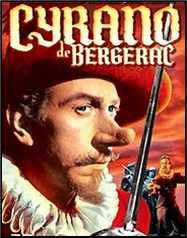
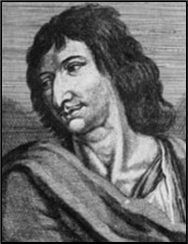 xxxxxThe French
verse dramatist Edmond Rostand is remembered especially for his
heroic comedy Cyrano de Bergerac. First
performed in Paris in December 1897, it
became an instant success all over Europe and the United States, and
has enjoyed a worldwide popularity ever since. Loosely based on the
real-
xxxxxThe French
verse dramatist Edmond Rostand is remembered especially for his
heroic comedy Cyrano de Bergerac. First
performed in Paris in December 1897, it
became an instant success all over Europe and the United States, and
has enjoyed a worldwide popularity ever since. Loosely based on the
real-
xxxxxTwo
of his other plays have survived the years. His first successful
drama, The Romantics, a tale of innocent
young love based on Shakespeare’s Romeo and
Juliet, was staged in Paris in 1894. It was adapted as an
American musical comedy with the title The
Fantasticks in 1960. The Eaglet,
produced in 1900, was a sentimental account of the life of the Duke
of Reichstadt Napoleon Bonaparte’s son. Axpatriotic tragedy in six acts, it provided Sarah Bernhardt (1844-
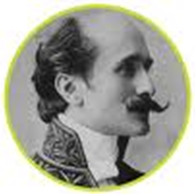 xxxxxRostand was born into a wealthy family in Marseilles in
1868, and was educated at the Collège Stanislas
in Paris. He produced his first book of poems, Les
Musardises, in 1890, the same year that his play The
Eaglet was staged. In 1901, following his enormous success
with Cyrano de Bergerac, he became the
youngest writer to be elected to the Académie française, but by then
his health was failing. He retired to his country estate at Cambon
in the French Basque country suffering from pleurisy. He continued
to write, but with diminishing success. One of his last plays Chantecler, premiered in February 1910, was a
xxxxxRostand was born into a wealthy family in Marseilles in
1868, and was educated at the Collège Stanislas
in Paris. He produced his first book of poems, Les
Musardises, in 1890, the same year that his play The
Eaglet was staged. In 1901, following his enormous success
with Cyrano de Bergerac, he became the
youngest writer to be elected to the Académie française, but by then
his health was failing. He retired to his country estate at Cambon
in the French Basque country suffering from pleurisy. He continued
to write, but with diminishing success. One of his last plays Chantecler, premiered in February 1910, was a
 study
of the animal world, based on the stories of the French fabulist La
Fontaine. All the characters were farmyard animals, and the story
was centred around a rooster named Chantecler, who believed that his
song made the sun rise. Rostand died in December 1918 during a visit
to Paris, a victim of the widespread influenza epidemic of that
year. He was buried in Marseilles Cemetery.
study
of the animal world, based on the stories of the French fabulist La
Fontaine. All the characters were farmyard animals, and the story
was centred around a rooster named Chantecler, who believed that his
song made the sun rise. Rostand died in December 1918 during a visit
to Paris, a victim of the widespread influenza epidemic of that
year. He was buried in Marseilles Cemetery.
xxxxxIncidentally, as one would expect, the story of Cyrano de Bergerac has been the subject of many films and television programmes, and has also featured as a musical and an opera.
Vc-
Including:
Pierre Loti

xxxxxAnother
outstanding French author at this time was Pierre
Loti, born Julien Viaud (1850-
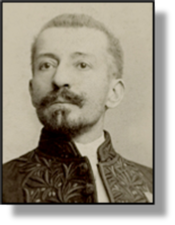 xxxxxAnother French writer at this time who proved extremely
popular was Pierre Loti,
born Julien Viaud (1850-
xxxxxAnother French writer at this time who proved extremely
popular was Pierre Loti,
born Julien Viaud (1850-
xxxxxAziyadé, his first major novel -
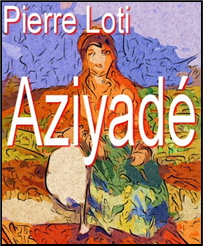
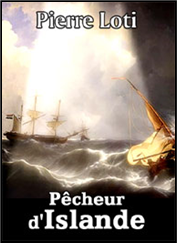 xxxxxOver the next ten years Loti wrote a series of novels,
all of which maintained his following. In 1881 came The
Romance of a Spahi, a tale set in Senegal and centred
around the love of a French colonial soldier for a black woman, and
a year later My Brother Yves, a moving
story about his friendship with a simple, hard-
xxxxxOver the next ten years Loti wrote a series of novels,
all of which maintained his following. In 1881 came The
Romance of a Spahi, a tale set in Senegal and centred
around the love of a French colonial soldier for a black woman, and
a year later My Brother Yves, a moving
story about his friendship with a simple, hard-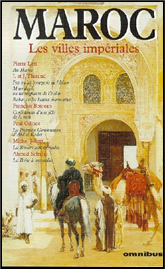 stage.
stage.
xxxxxHis
next three books, produced in the latter part of the 1880s, marked a
return to his travels in faraway, fascinating places. Madame
Chrysanthème, did much to increase further the public’s
fascination with all things Japanese, and his volume entitled Propos d’exil was a colourful collection of
short pieces about exotic places, laced with some fiction and semi-
xxxxxLoti was elected to the Académie française in 1891, and after producing a three volume work on his travels to The Holy Land, he was posted to Chinese Waters in 1895. It was while out there that he took part in the Boxer Rebellion of 1900, and obtained material for his account of The Last Days of Peking. And it was in 1900 that he published The Story of a Child, a somewhat embellished recollection of his childhood. Later works included Ramuntcho, a highly successful adventure story centred around contraband running in the Basque province of France, India without the English, Towards Isfahan (illustrated below), visited during his travels in Persia, and The Death of Philae, (the flooding of an island to make way for a dam), written soon after his journey on the Nile from Cairo to Aswan. After the First World War he wrote a book about the conflict, and two articles lamenting the collapse of the Turkish Empire.
xxxxxLoti
was the finest descri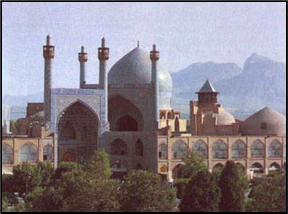 ptive
writer of his day. He possessed not only an exceptional gift of
observation, but also the ability to transfer his images to paper,
capturing with a few apt words the atmosphere, colour and sounds of
a scene or event. The accounts of his travels -
ptive
writer of his day. He possessed not only an exceptional gift of
observation, but also the ability to transfer his images to paper,
capturing with a few apt words the atmosphere, colour and sounds of
a scene or event. The accounts of his travels -
xxxxxLoti
died at Hendaye, a town on the Spanish border, after a long illness.
He was given a state funeral at his burial on the Ile d’Oléron, in
the Atlantic, due west of his home town of Rochefort. It is said
that on that day flags were flown at half-
xxxxxIncidentally, there are a number of explanations as to how Loti acquired his name. Perhaps the most likely one is that when serving in Tahiti in 1872 the natives had difficulty in pronouncing his name, Viaud, and named him after the island’s flower, the lotus. Whatever the reason, the name certainly stuck. ……
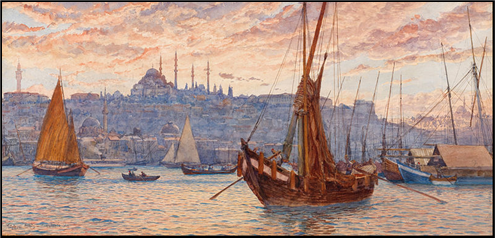
xxxxx…… Loti’s home at Rochefort, together with the adjoining premises, is now a museum dedicated to his life and work. It is full of Islamic architecture and works of art. One room is elaborately tiled as a mosque and another as a Turkish Salon. This is not surprising. He had a great love of the Middle East and regarded himself as “half Arab”. He was particularly well known in Istanbul where, to this day, there is a café named after him on a site overlooking the Golden Horn estuary (illustrated). ……
xxxxx…… It was after reading The Marriage of Loti, a very popular work in the 1880s, that the French artist Paul Gauguin decided to go to live in Tahiti, ostensibly to provide illustrations for a book. And a number of Loti’s works, particularly The Story of a Child, influenced the writing of the French novelist Marcel Proust. ……
xxxxx…… Throughout his travels he opposed change, wanting the countries he visited to remain sealed off from the outside world, free from Western commercialism. It was for this reason that he deplored the invasion of what he called “the Cookis and Cookesses”, tourists escorted abroad by the travel agent Thomas Cook and Son! ……
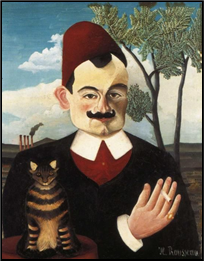 xxxxx…… While serving in the Far
East in 1883, the year before the outbreak of the Sino-
xxxxx…… While serving in the Far
East in 1883, the year before the outbreak of the Sino-
xxxxx…… The portrait of Pierre Loti illustrated here was by
the French post-


